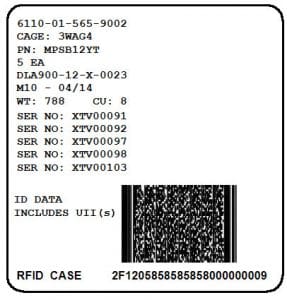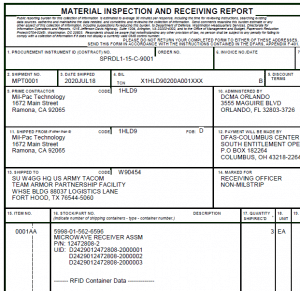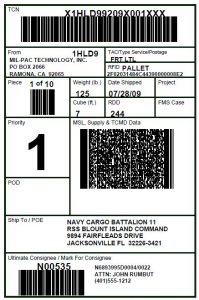The MIL-Comply DOD RFID solution helps determine the proper RFID label format in compliance with Mil-Std-129R, which can be a challenge. The standard requires that every container label be correctly formatted and contain absolutely accurate text and barcoded data.
The Mil-Std defines how suppliers are to identify cases and pallets with RFID tags and report that data to WAWF (Wide Area Workflow). The Standard avoids any rules for the appearance of RF-tagged labels, allowing DOD RFID solutions some latitude in creating efficient and highly-integrated systems.
Military Standard 129 has no specific RFID label formatting requirements because the tag itself can be anywhere on the container, and because it requires no printed identification. The RF tag ID and container level are often identified on the label, but this is for the convenience of those applying them rather than their use in the supply chain. It is definitely not a requirement. The reason for this is that due to the nature of RF-tags, which in order to work properly must sometimes be placed outside of the standard container label area. Thus, the Standard cannot tie their use to any specific label requirement.
RFID Label Formats for UID Containers
For shipments with IUIDs (Item Unique Identification), special UID label formats are required, but those requirements having nothing to do with RF-tag. However, because RFID and UID data must be aggregated together, printing them on the same label can reduce the sometimes overwhelming data management challenges.
Fortunately, MIL-Comply makes it fast and easy with a variety of label formats to meet the Mil-Std-129R requirements, and automatic data capture for WAWF submission. CSV file import of IUID shipments is supported.
MIL-Comply supports generic RFID labels, however, the real power of the software comes from using RF-enabled versions of standard container labels. All of the data that is needed for WAWF is collected while simply printing RF-variants of standard container labels. See some samples of different Mil-Std-129R label formats.
Submitting RFID Label Data to WAWF
For every RFID label shipped, you must report the tag ID to WAWF along with the quantity of the CLINs in the container. And report any UIDs in the containers. Add pallets and the shipment data can get very complex. A good DOD RFID solution must make efficient data collection and utilization a design priority.
To simplify things Comply/Labeling collects CLIN and IUID data as it prints labels and stacks pallets. This data is immediately available to send to WAWF as part of an electronic DD250 Receiving Report (EDI), or as a separate RFID Pack Update. It is quick and easy, and eliminates all of that exhausting manual data entry, which can easily result in errors. Just look at all of those numbers in the Container Data section of the illustration.
RFID Label Mandate Compliance
After printing labels there are three ways to get the RFID data into Wide Area Workflow:
- Manually enter the data into the WAWF web application
- Include it in an electronic Receiving Report (EDI) using MIL-Comply’s WAWF Automation capability (see example as PDF)
- Send an RFID Pack Update (EDI), which attach to Receiving Report previously submitted to WAWF (manually or via EDI).
The Pack Update option is also available when using MIL-Comply to submit Receiving Reports. This allows companies to separate the Governmental inspection and acceptance process from submission of the shipment’s RFID data.
Automate WAWF Receiving Reports
Most of the data necessary for a WAWF Receiving Report / DD250 (PDF example) is collected as shipments are labeled in Comply/Labeling. All that is left to do is pull a few addresses out of the MIL-Comply database and you are ready to submit the DD250 to WAWF. You can add prices and an invoice number and submit the invoice at the same time if you want.
Many companies actually start by creating the DD250, which provides most of the container and MSL labeling data. Labeling details like packaging method and date, transportation priority and container weights are added to support labeling. UIDs can be included in the shipment when the DD250 is created or at the time of labeling their containers.
MIL-Comply’s DOD RFID Solution combines power with flexibility:
-
Print RF-enabled versions of popular Mil-Std 129R labels
- Exterior Container
- Unit Container
- Military Shipment Label (MSL)
- “Generic” RFID label format for complete flexibility
- Print Pallet and Case RFID labels in one print job
- Automatically associate UID parts to RF-Cases
- Automatically associate RF-Cases to RF-Pallets
- Compatible with all leading RFID printers
- Submit RFID and UID (when applicable) data to WAWF, in either:
- WAWF DD250 Receiving Report (or Combo)
- RFID Pack Update
Get More Information
| Request detailed info with use cases | ||
| Keep up to date on MIL-Comply and DOD Compliance Requirements |
Read more about RFID systems and how RFID solutions help optimize the DOD supply chain.






